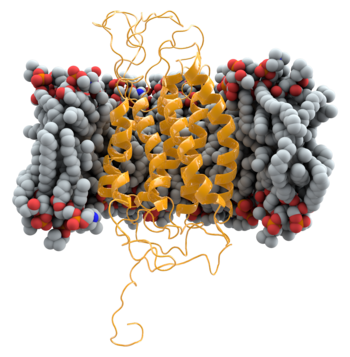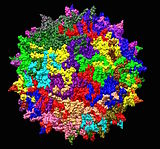Portal:Viruses
The Viruses Portal
Welcome!

Viruses are small infectious agents that can replicate only inside the living cells of an organism. Viruses infect all forms of life, including animals, plants, fungi, bacteria and archaea. They are found in almost every ecosystem on Earth and are the most abundant type of biological entity, with millions of different types, although only about 6,000 viruses have been described in detail. Some viruses cause disease in humans, and others are responsible for economically important diseases of livestock and crops.
Virus particles (known as virions) consist of genetic material, which can be either DNA or RNA, wrapped in a protein coat called the capsid; some viruses also have an outer lipid envelope. The capsid can take simple helical or icosahedral forms, or more complex structures. The average virus is about 1/100 the size of the average bacterium, and most are too small to be seen directly with an optical microscope.
The origins of viruses are unclear: some may have evolved from plasmids, others from bacteria. Viruses are sometimes considered to be a life form, because they carry genetic material, reproduce and evolve through natural selection. However they lack key characteristics (such as cell structure) that are generally considered necessary to count as life. Because they possess some but not all such qualities, viruses have been described as "organisms at the edge of life".
Selected disease
Yellow fever is an acute haemorrhagic fever caused by the yellow fever virus, an RNA virus in the Flaviviridae family. It infects humans, other primates, and Aedes aegypti and other mosquito species, which act as the vector. After transmission by the bite of a female mosquito, the virus replicates in lymph nodes, infecting dendritic cells, and can then spread to liver hepatocytes. Symptoms generally last 3–4 days, and include fever, nausea and muscle pain. In around 15% of people, a toxic phase follows with recurring fever, liver damage and jaundice, sometimes accompanied by bleeding and kidney failure; death occurs in 20–50% of those who develop jaundice. Infection otherwise leads to lifelong immunity.
The first definitive outbreak of yellow fever was in Barbados in 1647, and major epidemics have occurred in the Americas and southern Europe since that date. Yellow fever is endemic in tropical and subtropical areas of South America and Africa; its incidence has been increasing since the 1980s. An estimated 200,000 cases and 30,000 deaths occur each year, with almost 90% of cases being in Africa. Antiviral therapy is not effective. A vaccine is available, and vaccination, mosquito control and bite prevention are the main preventive measures.
Selected image
CCR5 is a human membrane protein that acts as a secondary receptor for HIV, enabling the viral and cell membranes to fuse. People with two copies of a mutated Δ32 form of CCR5 are naturally resistant to infection by most strains of HIV, and the normal form is the target of entry inhibitors such as maraviroc.
Credit: Thomas Splettstoesser (18 July 2012)
In the news
26 February: In the ongoing pandemic of severe acute respiratory syndrome coronavirus 2 (SARS-CoV-2), more than 110 million confirmed cases, including 2.5 million deaths, have been documented globally since the outbreak began in December 2019. WHO
18 February: Seven asymptomatic cases of avian influenza A subtype H5N8, the first documented H5N8 cases in humans, are reported in Astrakhan Oblast, Russia, after more than 100,0000 hens died on a poultry farm in December. WHO
14 February: Seven cases of Ebola virus disease are reported in Gouécké, south-east Guinea. WHO
7 February: A case of Ebola virus disease is detected in North Kivu Province of the Democratic Republic of the Congo. WHO
4 February: An outbreak of Rift Valley fever is ongoing in Kenya, with 32 human cases, including 11 deaths, since the outbreak started in November. WHO
21 November: The US Food and Drug Administration (FDA) gives emergency-use authorisation to casirivimab/imdevimab, a combination monoclonal antibody (mAb) therapy for non-hospitalised people twelve years and over with mild-to-moderate COVID-19, after granting emergency-use authorisation to the single mAb bamlanivimab earlier in the month. FDA 1, 2
18 November: The outbreak of Ebola virus disease in Équateur Province, Democratic Republic of the Congo, which started in June, has been declared over; a total of 130 cases were recorded, with 55 deaths. UN
Selected article
A prion is an infectious agent hypothesised to consist of protein. This is in contrast to viruses and other known infectious agents, which all contain one or both of the nucleic acids, DNA and RNA. Prions propagate by transmitting a misfolded protein state. The prion induces existing, properly folded proteins in the host to convert into the misfolded prion form. Abnormal protein aggregates called amyloids accumulate in infected tissue and are associated with tissue damage and cell death.
Prion variants of PrP are associated with the transmissible spongiform encephalopathies in mammals. Human prion diseases include Creutzfeldt–Jakob disease, Gerstmann–Sträussler–Scheinker syndrome, fatal familial insomnia, kuru and variably protease-sensitive prionopathy. Prion diseases of other mammals include bovine spongiform encephalopathy ("mad cow disease") in cattle, scrapie in sheep, and chronic wasting disease in deer. All known mammalian prion diseases affect the structure of the brain or other neural tissue. All are progressive, lack an effective treatment and are inevitably fatal. Proteins showing prion-type behaviour are also found in some fungi. Fungal prions do not appear to cause disease in their hosts.
Selected outbreak
The 2009 flu pandemic was an influenza pandemic first recognised in Mexico City in March 2009 and declared over in August 2010. It involved a novel strain of H1N1 influenza virus with genes from five different viruses, which resulted when a previous triple reassortment of avian, swine and human influenza viruses further combined with a Eurasian swine influenza virus, leading to the term "swine flu" being used for the pandemic. It was the second pandemic to involve an H1N1 strain, the first being the 1918 "Spanish flu" pandemic.
The global infection rate was estimated as 11–21%. This pandemic strain was less lethal than previous ones, killing about 0.01–0.03% of those infected, compared with 2–3% for Spanish flu. Most experts agree that at least 284,500 people died, mainly in Africa and Southeast Asia – comparable with the normal seasonal influenza fatalities of 290,000–650,000 – leading to claims that the World Health Organization had exaggerated the danger.
Selected quotation
| “ | There is no question that virology has long outgrown the confines of "Microbiology": it is an important discipline in its own right, a fact that is attested by the numerous high quality journals that are exclusively devoted to it. Further, it is primarily virology that has made possible the rapid rise of molecular cell biology. | ” |
—Bill Joklik on founding a society for virology
Recommended articles
Viruses & Subviral agents: bat virome • elephant endotheliotropic herpesvirus • HIV • introduction to viruses![]() • Playa de Oro virus • poliovirus • prion • rotavirus
• Playa de Oro virus • poliovirus • prion • rotavirus![]() • virus
• virus![]()
Diseases: colony collapse disorder • common cold • croup • dengue fever![]() • gastroenteritis • Guillain–Barré syndrome • hepatitis B • hepatitis C • hepatitis E • herpes simplex • HIV/AIDS • influenza
• gastroenteritis • Guillain–Barré syndrome • hepatitis B • hepatitis C • hepatitis E • herpes simplex • HIV/AIDS • influenza![]() • meningitis
• meningitis![]() • myxomatosis • polio
• myxomatosis • polio![]() • pneumonia • shingles • smallpox
• pneumonia • shingles • smallpox
Epidemiology & Interventions: 2007 Bernard Matthews H5N1 outbreak • Coalition for Epidemic Preparedness Innovations • Disease X • 2009 flu pandemic • HIV/AIDS in Malawi • polio vaccine • Spanish flu • West African Ebola virus epidemic
Virus–Host interactions: antibody • host • immune system![]() • parasitism • RNA interference
• parasitism • RNA interference![]()
Methodology: metagenomics
Social & Media: And the Band Played On • Contagion • "Flu Season" • Frank's Cock![]() • Race Against Time: Searching for Hope in AIDS-Ravaged Africa
• Race Against Time: Searching for Hope in AIDS-Ravaged Africa![]() • social history of viruses
• social history of viruses![]() • "Steve Burdick" • "The Time Is Now" • "What Lies Below"
• "Steve Burdick" • "The Time Is Now" • "What Lies Below"
People: Brownie Mary • Macfarlane Burnet![]() • Bobbi Campbell • Aniru Conteh • people with hepatitis C
• Bobbi Campbell • Aniru Conteh • people with hepatitis C![]() • HIV-positive people
• HIV-positive people![]() • Bette Korber • Henrietta Lacks • Linda Laubenstein • Barbara McClintock
• Bette Korber • Henrietta Lacks • Linda Laubenstein • Barbara McClintock![]() • poliomyelitis survivors
• poliomyelitis survivors![]() • Joseph Sonnabend • Eli Todd • Ryan White
• Joseph Sonnabend • Eli Todd • Ryan White![]()
Selected virus
Adeno-associated viruses (AAVs) are two small DNA viruses in the Dependoparvovirus genus of the Parvoviridae family. They cannot complete their lytic replication cycle without a helper virus, which include adenoviruses, herpesviruses and vaccinia. In the absence of the helper, AAVs can integrate into the host genome at a specific site on human chromosome 19, or persist as an episome. The 20 nm icosahedral capsid lacks an envelope, and contains a single-stranded DNA genome of around 4.7 kb. AAVs infect humans and some other primates without causing disease. They generate only a mild immune response, including neutralising antibodies. The best-studied of the 11 serotypes, AAV-2, infects nerve cells, liver cells, skeletal muscle and vascular smooth muscle, using heparan sulphate proteoglycan as its primary receptor.
Its low pathogenicity makes AAV an attractive basis for viral vectors for gene therapy. Alipogene tiparvovec to treat lipoprotein lipase deficiency was the first gene therapy to be licensed, but was later withdrawn. Promising results have been obtained in early clinical trials with AAV-based gene therapy in haemophilia, congestive heart failure, spinal muscular atrophy, Parkinson's disease and the rare eye disease Leber congenital amaurosis.
Did you know?
- ...that the protein ASF/SF2 (molecular image pictured) is involved in the development of the human heart and the replication of HIV-1?
- ...that in February 2020, Neil Ferguson and his team believed that significantly more people in China had been infected with the 2019 novel coronavirus than had been reported?
- ...that the outbreak of Ebola in Bundibugyo District in Uganda in 2007 was caused by a novel strain of the Ebola virus?
- ...that virologist John R. Paul blamed better hygiene for polio's spread in the 20th century, saying early exposure to poliovirus would have given immunity?
- ...that a novel human polyomavirus is associated with Merkel cell carcinoma, a rare and highly aggressive form of skin cancer?
Selected biography
Françoise Barré-Sinoussi (born 30 July 1947) is a French virologist, known for being one of the researchers who discovered HIV.
Barré-Sinoussi researched retroviruses in Luc Montagnier's group at the Institut Pasteur in Paris. In 1982, she and her co-workers started to analyse samples from people with a new disease, then referred to as "gay-related immune deficiency". They found a novel retrovirus in lymph node tissue, which they called "lymphadenopathy-associated virus". Their results were published simultaneously with those of Robert Gallo's group in the USA, who had independently discovered the virus under the name "human T-lymphotropic virus type III". The virus, renamed "human immunodeficiency virus", was later shown to cause AIDS. Barré-Sinoussi continued to research HIV until her retirement in 2015, studying how the virus is transmitted from mother to child, the immune response to HIV, and how a small proportion of infected individuals, termed "long-term nonprogressors", can limit HIV replication without treatment. In 2008, she was awarded the Nobel Prize, with Montagnier, for the discovery of HIV.
In this month
5 June 1981: First report of HIV/AIDS (symbol pictured) appeared in medical literature
6 June 1997: Gene silencing in plants shown to be a viral defence mechanism
7–13 June 1962: Donald Caspar and Aaron Klug proposed the quasi-equivalence principle of virus structure
7–13 June 1962: André Lwoff proposed a viral classification scheme based on nature of genome, type of symmetry and presence of envelope
7–13 June 1962: George Hirst proposed that the influenza virus genome is segmented
9 June 1981: The American Society for Virology was founded
13 June 2012: First case of Middle East respiratory syndrome coronavirus (MERS-CoV) occurred in Saudi Arabia
18 June 1981: A vaccine against foot-and-mouth disease was the first genetically engineered vaccine
21 June 1996: Nevirapine approved, first NNRTI for HIV/AIDS
26 June 1993: Clinical trial of hepatitis B virus drug fialuridine terminated; the drug caused several fatalities due to lactic acidosis
28 June 2011: FAO declared rinderpest eradicated
30 June 1985: Ryan White was denied re-admittance to his school after an AIDS diagnosis, in a case that changed public perceptions of the disease
Selected intervention
Several human papillomavirus (HPV) vaccines, including Cervarix and Gardasil, have been approved to protect against infections with particular types of HPV, associated with cervical and other cancers. All vaccines protect against the high-risk HPV types 16 and 18. Gardasil is a quadrivalent vaccine that additionally protects against low-risk HPV-6 and -11, which are associated with most cases of genital warts. A second-generation nine-valent Gardasil vaccine protects against five additional high-risk HPV types. It is estimated that the vaccines may prevent 70% of cervical cancer, 80% of anal cancer, 60% of vaginal cancer, 40% of vulvar cancer and possibly some oropharyngeal cancers. Protection lasts for at least 8–9 years. Some advocate giving Gardasil to men and boys with the primary aim of protecting their female sexual partners; others consider vaccinating only women and girls to be more cost effective. The licensed vaccines are subunit vaccines, containing only the L1 capsid protein of the virus, which self-assembles into virus-like particles. They are not effective in people already infected with HPV. Research is ongoing into therapeutic HPV vaccines including the viral oncoproteins, E6 and E7, but none has yet been licensed.
Subcategories
Subcategories of virology:
Topics
Things to do
- Comment on what you like and dislike about this portal
- Join the Viruses WikiProject
- Tag articles on viruses and virology with the project banner by adding {{WikiProject Viruses}} to the talk page
- Assess unassessed articles against the project standards
- Create requested pages: red-linked viruses | red-linked virus genera
- Expand a virus stub into a full article, adding images, citations, references and taxoboxes, following the project guidelines
- Create a new article (or expand an old one 5-fold) and nominate it for the main page Did You Know? section
- Improve a B-class article and nominate it for Good Article
 or Featured Article
or Featured Article status
status - Suggest articles, pictures, interesting facts, events and news to be featured here on the portal
WikiProjects & Portals
 WikiProject Viruses
Related WikiProjects
WikiProject Viruses
Related WikiProjects
Medicine • Microbiology • Molecular & Cellular Biology • Veterinary Medicine
Related PortalsAssociated Wikimedia
The following Wikimedia Foundation sister projects provide more on this subject:
-
Commons
Free media repository -
Wikibooks
Free textbooks and manuals -
Wikidata
Free knowledge base -
Wikinews
Free-content news -
Wikiquote
Collection of quotations -
Wikisource
Free-content library -
Wikispecies
Directory of species -
Wikiversity
Free learning tools -
Wiktionary
Dictionary and thesaurus



















